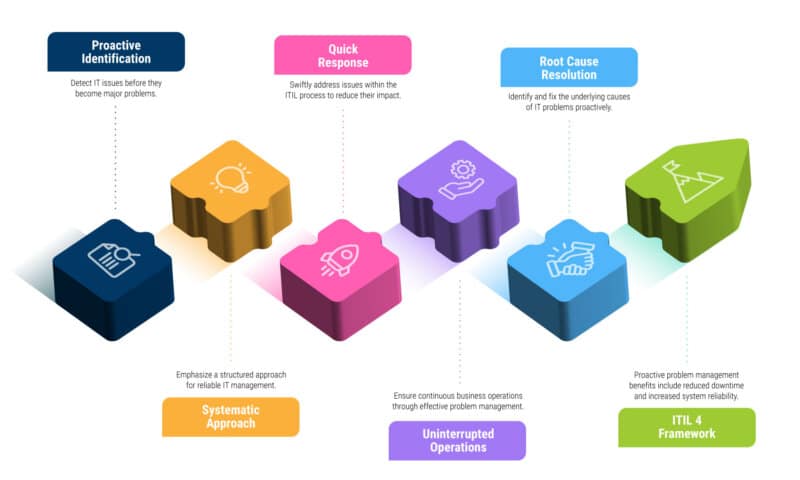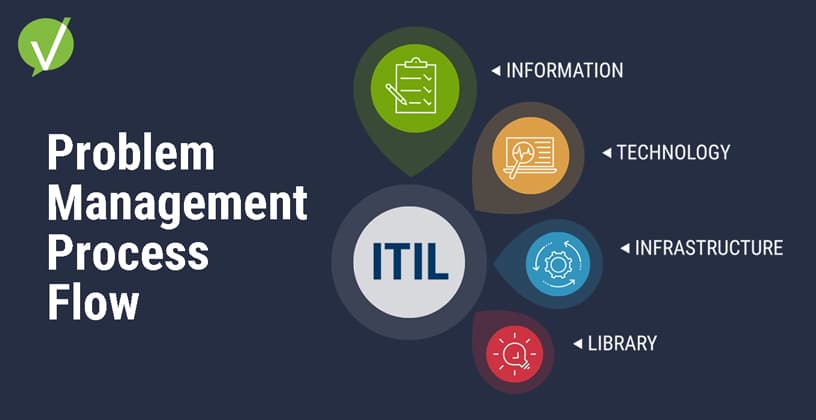ITIL Problem Management Process Flow: Resolving IT Challenges Effectively
Introduction
If you work in the field of Information Technology, you know issues are bound to arise sooner or later. Whether it’s a hardware malfunction or a software glitch, problems can impede the normal functioning of your IT systems, causing delays and frustration for your team and customers. This is where the ITIL Problem Management Process Flow comes in handy.
The ITIL Problem Management Process Flow is a systematic approach that helps identify, analyze, and resolve IT issues effectively. It involves tracking and monitoring potential problems before they occur and responding quickly to minimize their impact. The ITIL Problem Management Process Flow plays an integral role in maintaining system reliability, ensuring uninterrupted business operations, and resolving a problem.
Key Takeaways:
- The ITIL Problem Management Process Flow is a systematic approach that helps identify, analyze, and resolve IT issues effectively.
- It tracks and monitors potential problems before they occur and responds quickly, within an ITIL process, to minimize their impact.
- The ITIL Problem Management Process Flow ensures uninterrupted business operations and system reliability.
- By taking a proactive approach to problem management, organizations can identify and resolve the root cause of the problem before they disrupt normal functioning and cause significant damage.
- The ITIL Problem Management Process Flow is part of the ITIL 4 framework, which is designed to improve service delivery and enhance customer satisfaction.
Understanding ITIL Problem Management Process
IT Infrastructure Library (ITIL) Problem Management is a widely adopted process by organizations to identify and resolve an IT incident or problem. The process aims to identify the root causes of problems and prevent recurring issues.
The ITIL Problem Management Process involves two primary approaches: proactive and reactive. Proactive problem management aims to identify potential problems before they occur, whereas reactive problem management focuses on resolving existing problems.
With the release of ITIL 4, the problem management process has evolved to include more emphasis on proactive problem identification and resolution. Proactive problem management provides significant benefits to organizations, including reduced downtime and increased system reliability.

Roles and Responsibilities in Problem Management
Problem management is a critical process that involves several roles and responsibilities to ensure its effectiveness in resolving IT issues. One of the essential roles is the problem management team, responsible for managing the problem management effectively, from problem identification to resolution.
Having a dedicated Management Team can significantly improve problem management, as it ensures that there are enough resources to handle problems and that the process is running smoothly. The team comprises individuals with different skills and expertise, working together to address IT issues.
The importance of Defined Roles and Responsibilities cannot be overstated when it comes to problem management. Clear roles and responsibilities help in identifying the root cause of problems and speed up the resolution process. It also ensures that nothing falls through the cracks and that everyone understands their responsibilities in mitigating IT issues.
| Responsibility | Description |
|---|---|
| Problem Identification | The Problem Manager must identify the IT issues and classify them as problems. |
| Problem Logging | They must log all the problems and create problem records for each one of them. |
| Problem Tracking and Escalation | They must track the status of each problem and escalate them when necessary. |
| Problem Resolution | They must work with other teams to resolve the problems and ensure that they don’t reoccur. |
| Problem Review | They must conduct regular reviews to evaluate the effectiveness of the problem management process. |
Defined roles and responsibilities ensure that there is accountability in the problem management process, which, in turn, improves the overall efficiency and effectiveness of IT operations.
Problem Management Process Flow
Effective problem management involves a structured process flow. By following this process, you can capture a problem record that identifies the issue, its impact, and who is affected by it. Creating a problem record is the starting point of the process, and the record must be detailed and comprehensive. It will help track the progress of problem management and ensure that all relevant information is available for future reference.
The next step is to conduct a root cause analysis of the problem. This step helps identify the underlying causes of the issue and ensures that a permanent solution is put in place. It is important to remember that the root cause may not always be the most apparent symptom of the problem. The analysis should be thorough and take into consideration any previously identified problems.
The known error database should be used when resolving the problem. This database contains information on all incidents and known errors that have previously occurred. By using this information, you can identify any potential solutions that were previously used and ensure that they are implemented correctly.
Regular problem reviews are crucial to ensure that the process is continuously improving. During these reviews, data and metrics are examined to identify any trends or recurring issues. The insights gained can then be used to modify the problem management process, leading to more efficient and effective resolutions.
Problem Management Integration with Incident and Change Management
Effective problem resolution requires a holistic approach that integrates incident, change, and problem management processes. By doing so, organizations can ensure they are not just addressing symptoms but also targeting the underlying root causes of incidents. Incident management focuses on restoring service as quickly as possible, whereas problem management targets permanent solutions to eliminate the cause of recurring incidents. This integration plays a crucial role in maintaining system reliability, reducing downtime, and improving customer satisfaction.
Incident Resolution through Problem Management
The incident management process aims to restore normal operation as quickly as possible after a disruption. In contrast, problem management focuses on the identification, investigation, and resolution of underlying root causes to prevent future incidents. Through problem management, IT teams can determine the underlying causes of issues and address them to avoid recurring incidents. Therefore, ensuring an effective problem management process can lead to fewer incidents, less downtime, and lower operational costs.
Effective Change Management to Prevent Recurring Problems
Change management plays a crucial role in preventing recurring incidents by ensuring that changes are executed without introducing significant risks or errors. A planned and systematic approach to change management helps identify potential issues before they occur, reducing the possibility of incidents caused by changes. Integrating change management and problem management increases the visibility of the relationship between changes and problems, enabling IT teams to prevent recurring incidents and plan for future changes more effectively.
Best Practices and Benefits of ITIL Problem Management
Effective problem management is essential for the success of any organization. By following some of the best practices in ITIL problem management, you can ensure that your organization is well-equipped to handle IT challenges effectively. Here are some of the best practices you should follow:
- Define clear roles and responsibilities: Clearly define the roles and responsibilities of everyone involved in problem management to ensure effective problem resolution.
- Implement proactive problem identification: Implementing proactive problem identification allows you to address issues before they become major problems, enhancing service reliability.
- Establish problem management processes: Establish a well-defined problem management process that aligns with the management lifecycle. It should include a clear process flow, policies, and procedures to ensure consistent problem resolution.
- Utilize data and reporting: Collecting and analyzing data and reporting on problem management metrics will provide insights into problem trends and allow for continuous improvement.
- Ensure effective communication: Communication plays a crucial role in problem management. Ensure that stakeholders are kept informed of progress and resolution status to build trust and credibility.
By following these best practices, you can achieve effective problem management throughout the management lifecycle. This has several benefits for your organization, including:
- Reduced downtime: Proactively identifying and resolving problems reduces downtime and enhances service reliability, leading to increased customer satisfaction.
- Cost savings: Effective problem management reduces the cost of resolving IT incidents as problem resolution takes a root-cause approach.
- Improved service quality: By resolving problems through a structured problem management process, you can improve overall service quality and customer satisfaction.
- Increased productivity: By proactively identifying and resolving problems, you can free up resources to focus on other IT initiatives and improve productivity.
Effective problem management is critical to the success of any organization. By implementing some of the best practices in ITIL problem management, you can enhance service reliability, improve customer satisfaction, and achieve cost savings. Don’t overlook the value problem management can bring to your organization.
Unlock the potential of ITIL problem management process flow with Vivantio. With over 20 years of industry experience, Vivantio employs these best practices to guarantee the success of your problem management throughout your entire system. This translates to improved productivity, heightened customer satisfaction, and streamlined support processes. Get in touch with our Vivantio team today or sign up for a complimentary demo to empower your team in effortlessly addressing intricate challenges.













